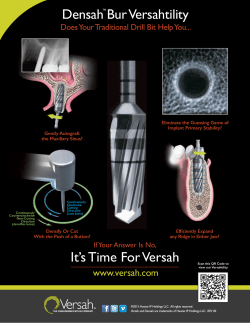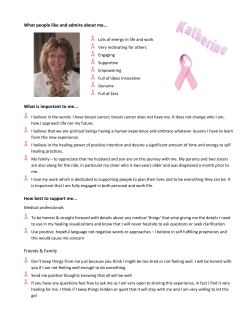
20-Slides - Healing
Section 20: Fracture Mechanics and Healing 20-1 20-2 From: Al-Tayyar Basic Biomechanics • Bending • Axial Loading – Tension T i – Compression • Torsion Bending Compression Torsion 20-3 From: Le Fracture Mechanics Figure from: Browner et al: Skeletal Trauma 2nd Ed, Ed Saunders, Saunders 1998. 1998 20-4 From: Le 20-5 From: Al-Tayyar Fracture Mechanics • Bending load: – Compression strength greater than tensile strength – Fails in tension Figure from: Tencer Tencer. Biomechanics in Orthopaedic Trauma, Lippincott, 1994. 20-6 From: Le Fracture Mechanics • Combined bending & axial load – Oblique fracture – Butterfly fragment Figure from: Tencer. Biomechanics in Orthopaedic Trauma Lippincott, Trauma, Lippincott 1994. 1994 20-7 From: Le 20-8 From: Vanwanseele Bone Healing • Direct – Primary bone healing – Cutting g cones – Seen with absolute stability • Indirect – Secondary bone healing – Callus formation; resorption at fx site; – Seen with relative stability 20-9 From: Justice Indirect Stages: • Inflammation – 1-7 days • Soft callus – 3 weeks • Hard callus – 3 – 4 months • Remodeling – months => years 20-10 From: Justice Relative Stability • Motion between fracture fragments g that is compatible with fracture healing. • Motion is below the critical strain level of tissue repair. i • Promotes indirect bone healing! • Examples: E l – IM nails – Bridge plate – External Fixator 20-11 From: Justice Absolute Stability • Compression of two anatomically reduced fracture fragments. • No displacement of the fracture under functional load. • Promotes direct bone healing! • Examples: – Lag screw – Plate => compression, buttress, neutralization – Tension band 20-12 From: Justice Bone Development and Healing The process of bone development is called ossification. There are two types of ossification: endochronal d h l and d intramembranous. Bone healing occurs in stages: fracture, granulation, callus, l lamellar ll bone, b and d normall contour. 20-13 From: Ames Chapter 5 – The Skeletal System Fracture Repair • Step 1: A A. B. Immediately after the fracture, extensive bleeding occurs. Over a period of several hours a large blood hours, clot, or fracture hematoma, develops. Bone cells at the site become deprived of nutrients and die. The site becomes swollen, painful, and inflamed. • Step A. B. C. D. 20-14 2: Granulation tissue is formed as the hematoma is infiltrated by capillaries and macrophages, which begin to clean up the debris. Some fibroblasts produce collagen fibers that span the break , while others differentiate into chondroblasts and begin secreting cartilage matrix. Osteoblasts begin forming spongy bone. This entire structure is known as a fibrocartilaginous callus and it splints the broken bone. From: Imholtz Fracture Repair • Step p 3: A. • Bone trabeculae increase in number and convert the fibrocartilaginous callus into a bony callus of spongy bone bone. Typically takes about 6-8 weeks for this to occur. Step 4: A. B. 20-15 During the next several months, the bony callus is continually remodeled. Osteoclasts work to remove the temporary supportive structures while osteoblasts rebuild the compact bone and reconstruct the bone so it returns to its original shape/structure shape/structure. From: Imholtz Biomechanics Intact/Healing Bone • Hierarchical structure – Collagen embedded with apatite – Decreased modulus with decreased apatite:collagen ratio • Fibrils organized to resist force 20-16 – Fibers organized into lamellae – Concentric Lemellae make an Osteon From: Justice Strength/Stiffness • Strength g p proportional p to density2 • Modulus proportional to d density it (2 to 3) • Age: increased modulus, bending strength from child to adult, then decrease • Holes/defects H l /d f t weaken k bone (round better than q ) square) • Strength proportional to 20-17 From: Justice diameter4 Fracture Mechanics • Fracture Callus 1 6 x stronger 1.6 t – Moment of inertia proportional to r4 – Increase in radius by callus greatly increases moment of inertia and stiffness 0 5 x weaker 0.5 k Figure from: Browner et al, Skeletal Trauma 20-18 2nd Ed, Saunders, 1998. From: Le Figure from: Tencer et al: Biomechanics in Orthopaedic Trauma, Lippincott, 1994. Fracture Mechanics • Time of Healing 20-19 – Callus increases with time – Stiffness increases with time i – Near normal stiffness at 27 days – Does not correspond to radiographs Figure from: Browner et al, Skeletal Trauma, 2nd Ed, Saunders, 1998. From: Le Remodeling of Bone • Wolff’s Law • Remodeling – balance between bone absorption of osteoclasts and bone formation by osteoblasts – osteoporosis –increase porosity of bone, decrease in density and strength, increase in vulnerability to fractures – piezoelectric effect – electric potential created when collagen fibers in bone slip relative to one another facilitates bone growth another, – use of electric and magnetic stimulation to facilitate bone healing 20-20 From: Brown
© Copyright 2025

















